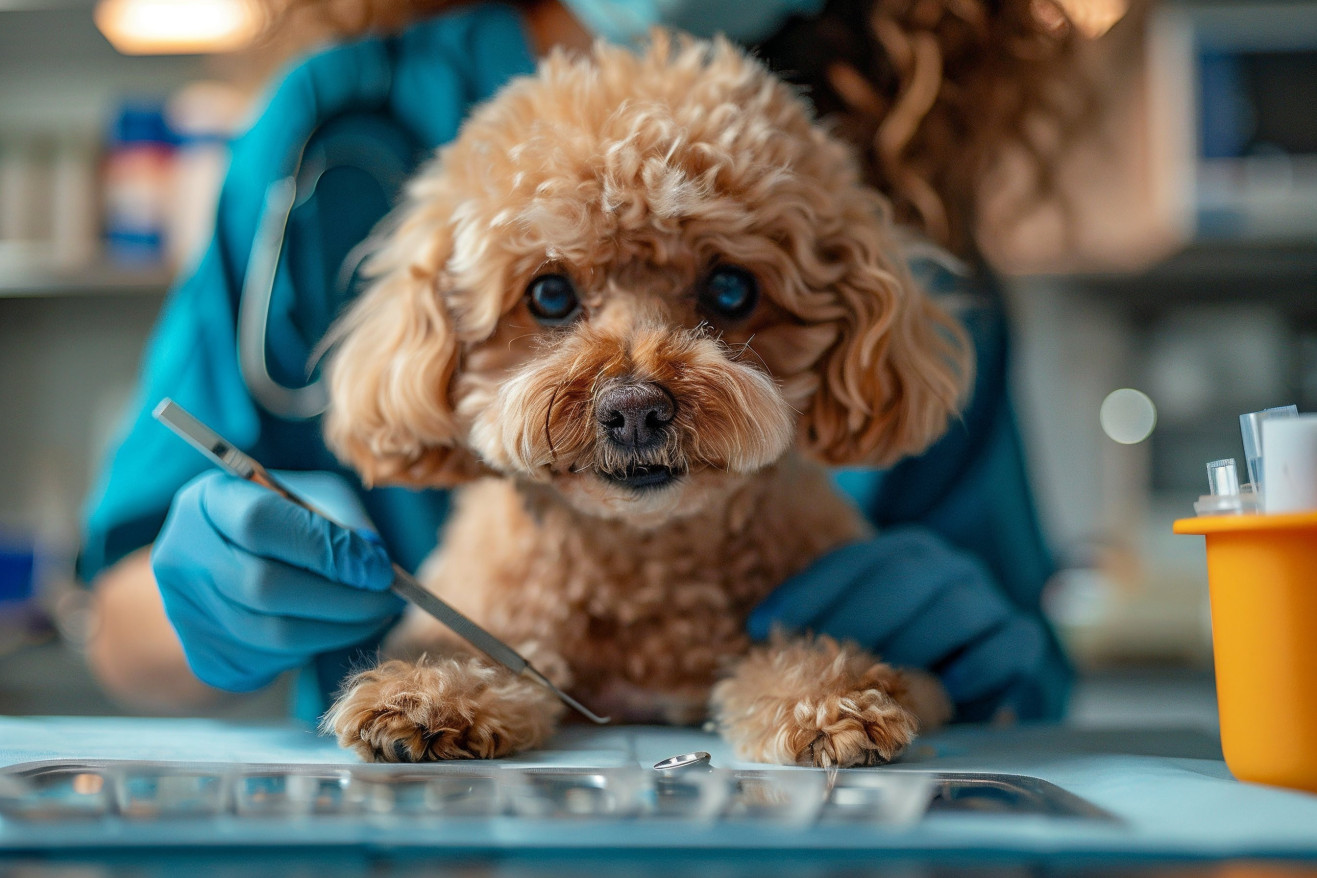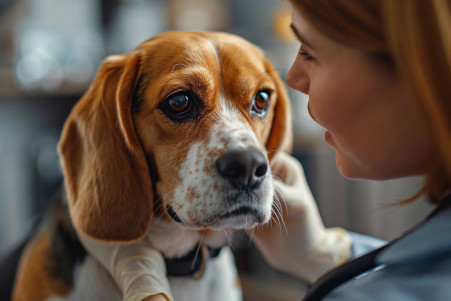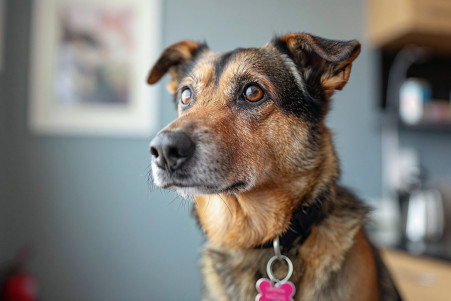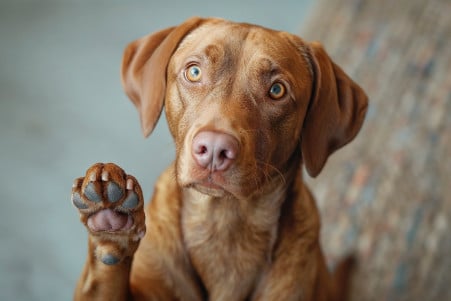Can Dogs Get Ingrown Hairs? Signs, Causes, and Prevention
18 May 2024 • Updated 18 May 2024

If you’ve ever seen your dog scratch at a particular area and wondered if dogs can get ingrown hairs, you’re not alone. Dogs can get ingrown hairs, and the condition is similar to that in humans. Ingrown hairs happen when a hair grows back into the skin or grows sideways, causing irritation, inflammation, and sometimes infection. Ingrown hairs are most likely to happen in areas where hair is thicker, like a dog’s legs, face, and armpits.
In this article, we’ll cover the causes, symptoms, and ways to prevent ingrown hairs in dogs, drawing on veterinary studies and the expertise of professional dog groomers. The goal of this article is to give you the information you need to make sure your dog is happy and healthy, especially if they’re prone to ingrown hairs. Knowing the signs and causes of ingrown hairs can help you make sure your dog is well-groomed and get them help if they need it.
Can dogs get ingrown hairs?
Causes and Risk Factors of Ingrown Hairs in Dogs
There are many potential causes and risk factors of ingrown hairs in dogs. According to Animal Friends Dermatology, bacterial, fungal, or parasitic infections are the most common causes of inflamed and ingrown hair follicles. Allergic skin conditions are said to be the most common cause of bacterial folliculitis.
In addition, systemic problems such as hormonal imbalances due to Cushing's disease or hypothyroidism can make dogs more susceptible, according to a study published by the National Institutes of Health. Immune-mediated diseases are also listed as a risk factor in the same study. Lack of proper grooming also contributes to the condition, with shaving a dog's hair too short or not brushing them enough being listed as potential causes of ingrown hairs by Paw Safe.
In addition, certain breeds are more susceptible due to their coat type. Dogs with short, rough coats like Boxers or dogs that are prone to calluses are more at risk, according to the American Kennel Club. Environmental factors such as moisture between the toes, pressure from laying on hard surfaces, and excessive licking can also cause hairs to become ingrown, according to Newsweek. Understanding these potential causes can help you prevent ingrown hairs that can cause your dog discomfort.
Symptoms of Ingrown Hairs in Dogs
Ingrown hairs in dogs can cause small, red, itchy bumps or pimple-like lesions on the skin, according to WagWalking. These bumps may also be filled with pus or have a discharge, which can be a sign of an infection. Dogs may also show signs of discomfort, such as licking, chewing, or scratching the area, according to The Spruce Pets.
In addition to these symptoms, ingrown hairs can also cause hair loss, swelling, and even an odor in the affected area, according to Embrace Pet Insurance. These symptoms can be more severe in areas of the body that are more prone to moisture, such as between the toes or skin folds. Knowing what to look for can help dog owners catch these symptoms early and get their pet to the vet for treatment before the condition worsens.
Veterinary Treatment Options for Ingrown Hairs in Dogs
For mild cases of ingrown hairs, veterinarians may recommend topical ointments, medicated shampoos, and warm compresses to reduce inflammation and promote healing, according to How to Spot and Treat Folliculitis in Dogs. For more severe or recurring cases, oral antibiotics or anti-inflammatory medications may be prescribed to address any underlying infections or allergies, as noted by How to treat folliculitis in dogs, according to a vet.
In some instances, surgical lancing or removal of the ingrown hair may be necessary to prevent further complications, states the Whole Dog Journal. Addressing any underlying conditions, such as hormonal imbalances or skin allergies, is crucial for long-term management of ingrown hairs. Regular grooming and proper coat maintenance can also help prevent future ingrown hairs and promote overall skin health.
Home Remedies and Natural Treatments for Ingrown Hairs
According to Your Complete Guide to Ingrown Hairs On Dogs: Treatment, Symptoms & Prevention, warm water soaks or Epsom salt baths can help to reduce inflammation and encourage any pus or discharge to drain. In addition, natural, antibacterial ingredients like coconut oil, beeswax, or essential oils can be used to help disinfect and moisturize the affected area, as recommended by Folliculitis in Dogs: Signs, Causes, & Care (Vet Answer) – Dogster.
Interdigital Cysts In Dogs: Home Treatment - Dogs Naturally notes that using gentle, non-irritating shampoos and conditioners can help to keep the coat healthy and prevent future ingrown hairs. In addition, the source notes that adding probiotics or omega-3 supplements to a dog's diet can help to promote skin health and reduce inflammation.
That said, it's always best to talk to a vet before trying any home remedies, especially in more severe or chronic cases, to make sure that the right treatment plan is being followed.
How to Prevent and Treat Ingrown Hairs in Dogs
Regular grooming, including brushing and trimming, can help prevent ingrown hairs by removing loose hair and keeping the coat healthy, according to Understanding and Treating Dog Ingrown Hair-Puainta®. Not shaving or cutting a dog's hair too short can also help prevent ingrown hairs, especially in areas with coarse hair, according to Do Ingrown Hairs Hurt Dogs? | The Pet Retreat.
A balanced diet and proper hydration can help maintain healthy skin and fur, according to What to Do If Your Dog Has an Impacted Hair Follicle?. In addition, using gentle, moisturizing shampoos and conditioners can help maintain the skin and fur, according to the same article.
Preventing and treating any allergies, infections, or hormonal issues can also help prevent ingrown hairs from coming back, according to Understanding and Treating Dog Ingrown Hair-Puainta®. With the right prevention and treatment, dog owners can help their pets avoid the pain and discomfort of ingrown hairs.
Conclusion: How to Help Your Dog Feel Better and Stay Healthy
As explained by Puainta®, dog ingrown hairs happen when a hair curls and grows back into the skin instead of growing outward. This can cause irritation, inflammation, and infection. Signs of dog ingrown hairs include redness, inflammation, itching, pus or discharge, pain, and visible hair trapped beneath the skin.
Causes of ingrown hairs in dogs can include inadequate grooming, skin disorders, trauma, allergies, hormonal imbalances, parasites, and genetic predisposition. Some breeds, especially those with thick double coats or curly/wiry hair textures, such as Poodles and Schnauzers, are more likely to develop ingrown hairs.
To avoid ingrown hairs, WagWalking suggests regular grooming, especially around sensitive areas, and a healthy, balanced diet. If your dog does develop ingrown hairs, you can help by using a warm salt water poultice and preventing your dog from licking or chewing the affected area. Long-term treatment may include antibiotics and regular cleaning.
With the right care, dog owners can make sure their pets stay healthy and happy and avoid the discomfort of ingrown hairs.


